
This post may contain affiliate links or sponsored content. That means if you click on my link and buy something, I will earn a small commission from the advertiser at no additional cost to you. For more information on this, please click here.
Sicilian Pasta with Cauliflower is both a taste and texture explosion, highlighting quintessential, Sicilian ingredients in the most harmonious combination ever! Hearty rigatoni is combined with tender, fork-smashed cauliflower, lots of deeply caramelized onions, toasted pine nuts, crispy fried capers and sweet, Marsala wine-soaked raisins–each component contributing a very intentional element to the final dish.

As the granddaughter of Sicilian immigrants, I was fortunate to grow up with the delicious flavors and dishes representative of that sunny Mediterranean island. Vegetables of all kinds were abundant, as were hearty pastas, simple meat dishes and pungent flavors like capers, vinegar and peperoncino. This Pasta with Cauliflower brings many flavors that are a wonderful representation of Sicilian cuisine together in a unique way.
For a few other recipes inspired by the flavors of la cucina Siciliana, check out Spaghetti with Breadcrumbs and Anchovies, Eggplant Meatballs, Trapanese Tomato Almond Pesto, Calamari Potato and Peas, Pasta with Tuna Sauce and Bucatini with Slow-Roasted Eggplant, Tomatoes and Ricotta, which is similar to the classic pasta alla norma,

What Inspired This Recipe
This recipe was inspired by the ingredients of Sicily and the memories of dishes lovingly prepared my dear mom and aunt. Smashed (read: overcooked) cauliflower was a staple in our kitchen (it’s an Italian thing). I’ve taken this ingredient in a slightly different direction, while maintaining the soul of the original dish that I grew up with.
Here, chunky rigatoni is paired with intentionally overcooked cauliflower and caramelized onions, then uniquely combined and topped with fried capers, toasted pine nuts and Sicilian, fortified Marsala wine-soaked raisins. The tender cauliflower breaks down and becomes a thick sauce with all of these sweet, savory and salty elements. Very special, indeed!
Although not as strong as Sicilian Caponata, this pasta has an element of agrodolce, or sweet and sour, a flavor brought to the Mediterranean island by the Arabs. It is very similar to a classic Sicilian pasta called pasta chi vruoccoli arriminati that includes anchovies, saffron and toasted breadcrumbs.
Cauliflower is a favorite vegetable in Sicily, and the island is known for lots of different varieties of it including purple “violet” and green “romanesco” cauliflower. I used regular white cauliflower here, but definitely make this recipe with other varieties if you can get your hands on them. Here’s a primer on different varieties of this versatile vegetable.
Raisins, pine nuts and capers are classic ingredients in Sicilian cuisine, and although combining them may sound a bit unusual, the flavors are subtle and blend together beautifully.
The layering of the unique flavors and textures in this recipe strike a characteristic savory-sweet balance that I hope you will love. Mangia bene!

Ingredients for Sicilian Pasta with Cauliflower
To make this delicious Sicilian Pasta with Cauliflower, we’ll be using the following main ingredients:
- Cauliflower: You can use either fresh or frozen cauliflower in this dish. Like Pasta with Broccoli, overcooking the cauliflower a bit until it is tender enough to be smashed with a fork is key to making it hug the pasta so that the pasta and cauliflower become one.
- Onions and Garlic: Onions and garlic generally act as important flavor builders in whatever dish they are in, as they do here. But, the fact that we are properly caramelizing the onions until they are tender and a rich, golden brown means that the onions are also contributing a significant richness and high level of umami (i.e., savoriness) to the finished recipe. Simply fantastic!
- Pine Nuts, Raisins and Capers: These three ingredients are all quintessential in Sicilian cuisine and traditional recipes. Here, they are presented in a not-so-traditional way and act as garnishes, each contributing a unique and individual taste and texture to the final dish. The pine nuts are toasted until nutty, the raisins are soaked in Sicilian Marsala wine until rehydrated and spongy, and the capers are fried in olive oil until crispy, adding an interesting crispy element to the dish. They complement each and the rest of the dish so beautifully!
- Marsala Wine: This Sicilian, fortified wine is used to rehydrate and plump the raisins, adding its signature sweetness along the way. Be careful–you just may get addicted to the Marsala-soaked raisins and find yourself adding them to everything from salads to antipasto platters to your next cocktail!
- Olive Oil: We use olive oil to fry the capers and sauté the vegetables. In addition, I suggest drizzling each the finished pasta with a very high quality extra-virgin olive oil.
- Pecorino Romano Cheese: Fold sheep’s milk Pecorino Romano cheese into the pasta as one of the last steps to add a distinct sharpness and richness to the dish.
- Pasta: While I used rigatoni in this recipe, it would also work with other “strong” pasta that the sauce can cling to, such as penne rigate, ziti, gemelli or bucatini.

Sicilian Pasta with Cauliflower Step-by-Step, Pro-Tips included!
Here are the main steps for how to make Sicilian cauliflower pasta:
- Prep and measure all ingredients. Then, prepare the fried capers by frying them in olive oil until crispy.
- PRO-TIP: You can make these capers 3 to 4 hours in advance and hold them, uncovered, at room temperature.
- Toast the pine nuts in a small, dry skillet until they are golden-brown and have a nutty aroma.
- PRO-TIP: This will only take a couple of minutes. Pine nuts will burn very quickly, so do not walk away from the stove when doing this!


- Immerse the raisins in Marsala wine in small bowl for at least 1 hour before using.
- PRO-TIP: This can be done several hours in advance and held at room temperature. Drain raisins before using.
- Slowly caramelize the onions in olive oil, stirring occasionally. This will take about 30 minutes or so.
- PRO-TIP: It’s important to properly caramelize the onions until they are tender and a rich, golden brown. This intense flavor is an important component to the complex flavors in this dish. For more details about caramelizing onions, click here.


- Once onions are properly caramelized, push them to one side of pan and add the garlic. Cook garlic for a few minutes until it softens and browns lightly.
- Meanwhile, bring a large pot of water to a boil. Once the water comes to a boil, add salt, then the cauliflower florets. Cook cauliflower until soft enough to mash with a fork (approximately 4 to 6 minutes).
- PRO-TIP: The key to this dish is actually overcooking the cauliflower! The pasta and cauliflower are not separate but rather become one. You want the cauliflower to be mashed and then coat the pasta itself. Trust me on this one! Cook the cauliflower longer than what may feel comfortable.


- Remove the cooked cauliflower with a hand strainer or spider and transfer it to the onion mixture.
- Using a large fork or potato masher, smash the cauliflower and mix it with the onions and garlic. Season with salt and black pepper, then reserve it on low heat. Use a little pasta water to scrape up the brown bits on the bottom of the pan, if necessary.
- PRO-TIP: If after you’ve removed the cauliflower from the salted water and added it to the pan, you realize that it is not yet soft enough to smash, just add a bit of water to the pan and cover it. This will allow the cauliflower to steam/cook a bit more until it is at the right (smashable) texture.


- Once the cauliflower is removed from the boiling water, add the pasta and stir regularly. Cook for 2 minutes less than the package directions, or about 2 minutes before you think it is al dente. Be sure to reserve at least 1 cup of the starchy pasta water.
- PRO-TIP: The pasta water is key! Add it to the sauce along with the pasta for the additional moisture needed to finish cooking the pasta.
- When the pasta is ready, transfer it to the cauliflower mixture along with some starchy reserved cooking water. Stir well to fully combine all ingredients and let the pasta finish cooking in the sauce.


- Once the pasta is al dente, turn off the heat, then fold in the parsley, Pecorino cheese and half of the fried capers, toasted pine nuts and Marsala-soaked raisins. Drizzle a healthy glug of high-quality olive oil over the pasta at this point and stir.
- Transfer pasta to a large serving platter and top with remaining capers, pine nuts and raisins and additional Pecorino, if desired.


Check out my answer to “How Much Salt Should You Add to Pasta Water?” here, as featured in Appetito’s online Italian Food and Drink Magazine. (Hint: I also mention it in the recipe below.)

Frequently Asked Questions
Here are answers to some frequently asked questions about this Italian pasta dish with cauliflower:
Definitely! You can absolutely make this dish with frozen cauliflower! You can even add the frozen cauliflower directly to the boiling water, but it will take longer to become fork-tender than if it was fresh.
You can, but it is not necessary. The way that I have presented the recipe here makes the preparation super easy. Just cook the cauliflower in the boiling pasta water before adding the pasta, then remove the cooked cauliflower and transfer it to a pan with sautéed onions and garlic. Then proceed with cooking the pasta in the same water in which you just cooked the cauliflower.
The toasted pine nuts, Marsala wine-soaked raisins and fried capers are what make this pasta recipe so unique and interesting and give it great texture. (They also increase the Sicilian-ness of the recipe immeasurably!) Having said this, you will still have a beautifully delicious pasta if you decide to leave them out.
The best substitute for Marsala wine is Madeira, which is also a fortified wine with a similar flavor profile, or sherry, sweet vermouth and port. For a non-alcoholic option, I suggest rehydrating the raisins in either sherry vinegar, apple cider vinegar or plain warm water.
Store leftovers in an airtight container in the refrigerator for up to 5 days. Reheat them, covered, in a small skillet over medium low heat with a little bit of water until heated through.

Try serving this recipe with Sautéed Broccoli Rabe or Eggplant Milanese–both are delicious pairings!
Variations and Substitutions for Sicilian Pasta with Cauliflower
Here are a few great suggestions for twists and additions to this meatless pasta recipe:
- Use broccoli: This recipe work really well if you substitute either fresh or frozen broccoli for the cauliflower. Use the same exact technique.
- Add anchovy and/or olives: For a briny and umami punch, add a few filets of anchovy and/or chopped olives to the pan along with the onions.
- Add protein: Italian sausage would be a great addition to this dish for additional protein.
- Make it spicy! For all the hot pepper lovers, either add some crushed red pepper or Calabrian chile paste at the beginning of the cooking process (or both). And, of course, don’t forget to drizzle some homemade spicy pepper oil over the finished dish!
- Make it vegan: If you omit the cheese, this dish will be 100% plant-based and still amazingly delicious.

More Pasta Recipes with Veggies
If you love pairing pasta with lots of veggies, here are a few more recipes to try out:
- Vodka Sauce with Fresh Tomatoes & Basil-a fresh twist on this classic!
- Pasta with Broccoli and Lemon–a crowd favorite!
- Paglia e Fieno Pasta with Mushrooms and Peas–creamy and delicious!
- Trapanese Pesto with Busiate Pasta–a classic, Sicilian, raw tomato and almond pesto
- Pasta alla Checca–a super-easy, no-cook, tomato and ricotta sauce that anyone can make!

Kitchen Tools & Cookware Needed
To make this Italian Cauliflower Pasta recipe, you’ll need the following:
- Cutting board with non-slip mat underneath (I use shelf liner)
- Sharp chef’s knife
- Measuring cups and spoons
- Multiple bowls to hold prep
- Cheese grater (optional)
- Slotted spoon
- Small skillet
- Large sauté pan or Dutch oven
- Wooden or silicon spoons, tongs
- Potato masher or fork
- Large pot for cooking pasta
- Colander, large mesh strainer or spider for scooping out or draining pasta
- Large serving bowl or platter and serving utensils

More Italian Pasta Recipes to Try
I hope that you are enjoying my Italian food blog Mangia With Michele and all of my Italian recipes!
If you’ve tried this or another recipe here, let me know how it went in the comments below. I love hearing from you!
FOLLOW ME on FACEBOOK and INSTAGRAM to see more delicious food and what might be going on behind the scenes!
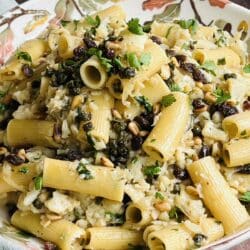
Sicilian Pasta with Cauliflower
Ingredients
- 5 Tbsp olive oil, divided
- ½ cup drained capers (about 3 ounces or 1–5.3 ounce jar, drained)
- ½ cup pine nuts (about 2 ounces)
- ½ cup raisins
- ⅓ cup dry or sweet Marsala wine
- 2 large yellow onions, sliced thin (about 1¼ pounds)
- ¼ cup chopped garlic
- 1 head cauliflower, florets only cut into medium-sized pieces (about 2½ pounds)
- ½ tsp salt
- ¼ tsp black pepper
- 1 pound rigatoni or other short pasta + salt for pasta water
- ½ cup chopped flat-leaf parsley
- ½ cup grated Pecorino Romano cheese + more for topping
- Extra virgin olive oil, for finishing
Instructions
- Prep and gather all ingredients according to specifications above.(Please see the section above in the blog post for Step-By-Step instructions with photos.)
- Prepare fried capers: First, make sure that capers are completely dry by placing them on paper towels and patting them dry. Then, heat 2 tablespoons olive oil in small skillet over medium heat. Once oil is hot, add capers and fry for about 4 minutes or until they get crispy, stirring occasionally. Using a slotted spoon, transfer them to a paper towel to drain and set aside, uncovered, at room temperature. (You can make these capers 3 to 4 hours in advance and hold them, uncovered, at room temperature.)½ cup drained capers
- Toast pine nuts: Place pine nuts in a small, dry skillet that fits them easily in a single layer over medium-low heat. Stir them occasionally until they are golden-brown and have a nutty aroma. This will only take a couple of minutes. Pine nuts will burn very quickly, so do not walk away from the stove when doing this!½ cup pine nuts
- Immerse the raisins in Marsala wine in a small bowl for at least 1 hour before using. This can be done several hours in advance and held at room temperature. Drain raisins before using.½ cup raisins, ⅓ cup dry or sweet Marsala wine
- Bring a large pot of water to a boil. Then heat remaining 3 tablespoons olive oil in large skillet or Dutch oven over medium-high heat, then add the onions. Reduce heat to medium and slowly caramelize onions, stirring occasionally. This will take about 30 minutes or so.2 large yellow onions,
- Once onions are properly caramelized, push them to one side of pan and add the garlic. Cook garlic for a few minutes until it softens and browns lightly.¼ cup chopped garlic
- Once the water comes to a boil, add salt, then the cauliflower florets. Cook cauliflower until soft enough to mash with a fork (approximately 4 to 6 minutes). Remove it with a hand strainer or spider and transfer it to the onion mixture.1 head cauliflower,
- Using a large fork or potato masher, smash the cauliflower and mix it with the onions and garlic. Use a little pasta water to scrape up the brown bits on the bottom of the pan, if necessary. Season with salt and black pepper, then reserve it on low heat.½ tsp salt, ¼ tsp black pepper
- Once the cauliflower is removed from the boiling water, add the pasta and stir regularly. Cook for 2 minutes less than the package directions, or about 2 minutes before you think it is al dente. Be sure to reserve at least 1 cup of the starchy pasta water.1 pound rigatoni
- When the pasta is ready, transfer it to the cauliflower mixture along with about ½ cup of the starchy pasta water (to start). Stir well to fully combine all ingredients and let the pasta finish cooking in the sauce and absorb all of those wonderful flavors! Add the additional pasta water if more moisture is needed.
- Once the pasta is al dente, turn off the heat, then fold in the parsley, Pecorino cheese and half of the fried capers, toasted pine nuts and Marsala-soaked raisins. Drizzle a healthy glug of high-quality olive oil over the pasta at this point and stir.½ cup chopped flat-leaf parsley, ½ cup grated Pecorino Romano cheese, Extra virgin olive oil,
- Transfer pasta to a large serving platter and top with remaining capers, pine nuts and raisins and additional Pecorino, if desired. Buon Appetito!
Notes
- Frozen cauliflower can be substituted for the fresh cauliflower.
- It’s important to properly caramelize the onions until they are tender and a rich, golden brown. This intense flavor is an important component to the complex flavors in this dish.
- The key to this dish is actually overcooking the cauliflower! The pasta and cauliflower are not separate but rather become one. You want the cauliflower to be mashed and then coat the pasta itself. Trust me on this one! Cook the cauliflower longer than what may feel comfortable.
- If after you’ve removed the cauliflower from the boiling water and added it to the pan, you realize that it is not yet soft enough to smash, just add a bit of water to the pan and cover it. This will allow the cauliflower to steam/cook a bit more until it is at the right (smashable) texture.
- Use a large pot with 5 to 6 quarts water for 1 pound of pasta. Bring the water to a boil before adding the salt. Use 1 1/2 – 2 Tbsp salt.
- The pasta water is key! Add it to the sauce along with the pasta for the additional moisture needed to finish cooking the pasta.
- While I used rigatoni in this recipe, it would also work with other “strong” pasta that the sauce can cling to, such as penne rigate, ziti, gemelli or bucatini.

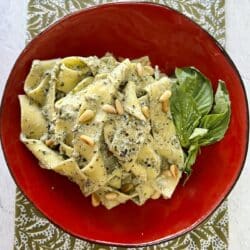
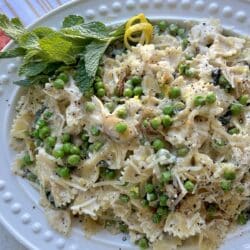
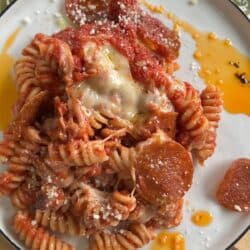
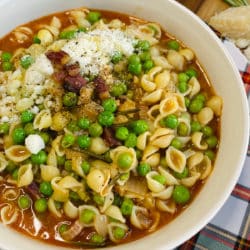

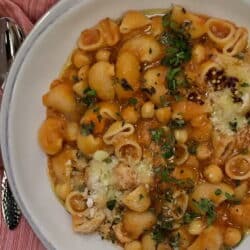

Fabulous recipe! Just made it for dinner. A keeper…
Fabulous recipe!
Such a delicious recipe! My family really enjoyed this very unique and tasty dish! Will definitely make again!
So glad that you and your family enjoyed the recipe, Anne! Thanks for the comment.:)
Outstanding recipe and very unique. My family loved it-will definitely be making it again!